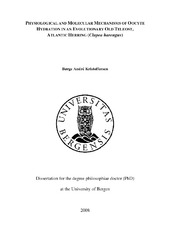| dc.contributor.author | Kristoffersen, Børge André | eng |
| dc.date.accessioned | 2008-12-17T10:01:38Z | |
| dc.date.available | 2008-12-17T10:01:38Z | |
| dc.date.issued | 2008-04-11 | eng |
| dc.identifier.isbn | 9788230805503 (print version) | en_US |
| dc.identifier.uri | http://hdl.handle.net/1956/3078 | |
| dc.description.abstract | This work investigated physiological and molecular mechanisms of oocyte hydration in Atlantic herring (Clupea harengus). Both inorganic and organic solutes were found to be important solutes involved in the hydration process. Inorganic ions represented the dominant osmolytes (71%) while a small pool of free amino acids (FAA) contributed 29% to egg osmolality (Paper I). To understand the origin of the pool of FAA that appear during this period, the molecular processing of vitellogenin (Vtg) and its derivative yolk proteins (Yp) were studied (Paper II). The findings were integrated into a wider context of teleost evolution and biodiversity by examining the phylogenetic relationships of teleost Vtgs in relation to vertebrate whole genome duplications (WGD) and the oceanic radiation of teleosts (Paper III). Atlantic herring is a marine teleost belonging to the Clupeiformes that spawns benthic eggs (benthophil). It is a representative of one of the first teleost orders to reinvade the oceans during the early Cretaceous. Oocyte hydration in this species is modest, rising from a relative water content of 59% in post-Vtg oocytes to 70-72% in ovulated eggs (OV egg). The major inorganic and organic osmolytes responsible for driving oocyte hydration are Cl-, K+, Pi, and a small pool of FAA, respectively. K+ (autumn and spring spawners) and Pi (spring) maintain their concentrations in the ovulated eggs, while other measured ions, Cl-, Na+, NH4 +, and Mg2+ are significantly diluted during the hydration process. In contrast, the concentration of FAA increased during this phase. Due to the low water content of these eggs the relatively small increase in FAA from 1.5% up to 3.3% of dry mass contributed 29% to the calculated ovoplasmic osmolality. To determine the origin of the FAA pool in Atlantic herring, a hepatically expressed vtg transcript was cloned and the deduced Vtg product examined in relation to the deposited oocyte and egg Yps. Unlike all teleosts studied to date, only a single complete type vtg transcript (chvtgAa) was found to be expressed. Genomic analyses of exon-intron structures conserved between vtgs of Atlantic herring and zebrafish show that at least two vtg genes exist in the genome, but that Atlantic herring has only a single form of vtg. Partial degradation of Yps in the OV egg showed that moderate proteolytic processing takes place during oocyte hydration. The phosvitin domain, the smallest yet reported for teleosts, and an N-terminal fragment of the lipovitellin light chain are suggested to be the precursors of the FAA pool. Molecular evidence for the presence of the Cterminal coding region of Vtg in the Yp pool is also presented for the first time in any teleost. Conserved maturational-cleavage sites were identified by N-terminal microsequencing and the 3D homology of Yp products of Atlantic herring were verified by mapping to the crystallographically resolved structure of lamprey lipovitellin. Multiple methods of phylogenetic analyses of the vtg cDNA and Vtg amino acid sequences placed Atlantic herring at the basal root of the Clupeocephala, in full congruence with current understanding of teleost phylogeny. Integration of phylogenetic analyses of all currently available vertebrate vtg sequences (expressed and genomic) with the environmental history of fishes, the three rounds of WGD, and the end-point of lipovitellin heavy chain degradation led to the proposal of a new vertebrate vtg gene nomenclature. These combined data further led to the proposal that the neo-functionalisation of duplicated vtg genes was a key event in the evolution and success of the teleosts in the oceanic environment. | en_US |
| dc.language.iso | eng | eng |
| dc.publisher | The University of Bergen | en_US |
| dc.relation.haspart | Paper I: Marine Biology 154(4), Kristoffersen, B. A. and Finn, R. N., Major osmolyte changes during oocyte hydration of a clupeocephalan marine benthophil: Atlantic herring (Clupea harengus), pp. 683-692. Accepted version (in press). Copyright 2008 Springer-Verlag.Submitted version. <a href="http://dx.doi.org/10.1007/s00227-008-0961-8" target="blank">http://dx.doi.org/10.1007/s00227-008-0961-8</a> | en_US |
| dc.relation.haspart | Paper II: Kristoffersen, B. A.; Nerland, A.; Nilsen, F.; Kolarevic, J. and Finn, R. N., (2008), Genomic and proteomic analyses reveal a single form of vitellogenin in the basal clupeocephalan. Manuscript to be submitted to Molecular Biology and Evolution. Published by Oxford University Press. Accepted verson. | en_US |
| dc.relation.haspart | Paper III: PLoS ONE 2(1), Finn, R. N. and Kristoffersen, B. A.,Vertebrate Vitellogenin Gene Duplication in Relation to the "3R Hypothesis": Correlation to the Pelagic Egg and the Oceanic Radiation of Teleosts, e169. Copyright 2007 Finn, Kristoffersen. Published by Public Library of Science. This is an open-access article distributed under the terms of the Creative Commons Attribution License, which permits unrestricted use, distribution, and reproduction in any medium, provided the original author and source are credited. Published version. <a href="http://dx.doi.org/10.1371/journal.pone.0000169" target="blank">http://dx.doi.org/10.1371/journal.pone.0000169</a> | en_US |
| dc.title | Physiological and molecular mechanisms of oocyte hydration in an evolutionary old teleost, Atlantic herring (Clupea harengus) | en_US |
| dc.type | Doctoral thesis | |
| dc.subject.nsi | VDP::Matematikk og Naturvitenskap: 400::Zoologiske og botaniske fag: 480::Marinbiologi: 497 | nob |



